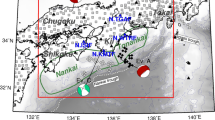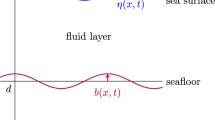Abstract
We investigated the development of a distinct later phase observed at stations near the Japan Trench associated with shallow, outer-rise earthquakes off the coast of Sanriku, northern Japan based on the analysis of three-component broadband seismograms and FDM simulations of seismic wave propagation using a heterogeneous structural model of the Japan Trench subduction zone. Snapshots of seismic wave propagation obtained through these simulations clearly demonstrate the complicated seismic wavefield constructed by a coupling of the ocean acoustic waves and the Rayleigh waves propagating within seawater and below the sea bottom by multiple reflections associated with shallow subduction zone earthquakes. We demonstrated that the conversion to the Rayleigh wave from the coupled ocean acoustic waves and the Rayleigh wave as they propagate upward along the slope of seafloor near the coast is the primary cause of the arrival of the distinct later phase at the station near the coast. Through a sequence of simulations using different structural models of the Japan Trench subduction zone, we determined that the thick layer of seawater along the trench and the suddenly rising sea bottom onshore of the Japanese island are the major causes of the distinct later phase. The results of the present study indicate that for realistic modeling of seismic wave propagation from the subduction zone earthquakes, a high-resolution bathymetry model is very crucial, although most current simulations do not include a water column in their simulation models.















Similar content being viewed by others
References
Chew, W.C. and Liu, Q. (1996), Perfectly matched layers for elastodynamics: a new absorbing boundary condition, J. Comput. Acoust., 4, 341-359.
Essen, H. -H., Grevemeyer, I., Herber, R. and Weigel, W. (1998), Shear-wave velocity in marine sediments on young oceanic crust: constraints from dispersion analysis of Scholte wave, Geaphys. J. Int., 132, 227-234.
Furumura, T., Hayakawa, T., Nakamura, M., Koketsu, K. and Baba, T. (2008), Development of long-period ground motions from the Nankai Trough, Japan, earthquakes: observations and computer simulation of the 1944 Tonankai (Mw 8.1) and the 2004 SE off-Kii Peninsula (Mw 7.4) earthquakes, Pure Appl. Geophys., 165, 585-607, doi:10.1007/s00024-008-0318-8.
Kanamori, H. (1971), Seismological evidence for a lithospheric normal faulting—the Sanriku earthquake of 1933, Phys. Earth Planet. Inter., 4, 289-300.
Kugler, S., Bohlen, T., Forbriger, T., Bussat, S. and Klein, G. (2007), Scholte-wave tomography for shallow-water marine sediments, Geophys. J. Int., 168, 551-570.
Hatayama, K. (2004), Theoretical evaluation of effects of sea on seismic ground motion, in Proceedings of the 13th World Conference on Earthquake Engineering, Vancouver, Canada, 2004, paper 3229.
Henriet, J. P., Schittekat, J. and Heldens, Ph. (1983), Borehole seismic profiling and tube wave applications in a dam site investigation, Geophys. Prospect., 31, 72-86.
Herrmann, R. B. (1979), SH-wave generation by dislocation sources – a numerical study, Bull. Seism. Soc. Am., 69, 1-15.
Hestholm, S. O. (1999), Three-dimensional finite difference viscoelastic wave modeling including surface topography, Geophys. J. Int., 139, 852–878.
Hino, R., Azuma, R., Ito, Y., Yamamoto, Y., Suzuki, K., Tsushima, H., Suzuki, S., Miyashita, M., Tomori, T., Arizono, M. and Tange, G. (2009), Insight into complex rupturing of the immature bending normal fault in the outer slope of the Japan Trench from aftershocks of the 2005 Sanriku earthquake (Mw = 7.0) located by ocean bottom seismometry, Geochem. Geophys. Geosyst., 10, Q07O18, doi:10.1029/2009GC002415.
Nakanishi, I. (1992), Rayleigh waves guided by sea-trench topography, Geophy. Res. Lett., 19, 2385-2388.
Okada, Y., Kasahara, K., Hori, S., Obara, K., Sekiguchi, S., Fujiwara, H. and Yamamoto, A. (2004), Recent progress of seismic observation networks in Japan–Hi-net, F-net, K-NET and KiK-net –, Earth Planets Space, 56, xv-xxviii.
Okamoto, T. and Takenaka, H. (2005), Fluid-solid boundary implementation in the velocity-stress finite-difference method, Zisin 2, 57, 355-364 (in Japanese with English abstract).
Petukhin, A., Iwata T. and Kagawa, T., (2010), Study on the effect of the oceanic water layer on strong ground motion simulations, Earth Planets Space, 62, 621-630.
Shapiro, N. M., Olsen, K. B. and Singh, S. K. (2000), Wave-guide effects in subduction zones: evidence from three-dimensional modeling, Geophys. Res. Lett., 27, 433-436.
Yomogida, K., Okuyama, R. and Nakanishi, I. (2002), Anomalous Rayleigh-wave propagation along oceanic trench, Stud. Geophys. Geod., 46, 691-710.
Acknowledgments
We used the waveform record of the F-net broadband network operated by the National Research Institute for Earth Science and Disaster Prevention (NIED), Japan. We also acknowledge the NIED and Japan Oceanographic Data Center, Japan for providing subsurface structure and seafloor topography data, respectively. A part of numerical simulations presented in this study was performed by the Earth Simulator in the Japan Agency for Marine-Earth Science and Technology. The present study was supported through the ‘Integrated Predictive Simulation System for Earthquake and Tsunami Disaster’ project of CREST, which is funded by the Japan Science and Technology Agency. We are grateful for kind management for our manuscript by John Rundle. We appreciate valuable comments from an anonymous reviewer for us to improve the manuscript.
Author information
Authors and Affiliations
Corresponding author
Rights and permissions
About this article
Cite this article
Noguchi, S., Maeda, T. & Furumura, T. FDM Simulation of an Anomalous Later Phase from the Japan Trench Subduction Zone Earthquakes. Pure Appl. Geophys. 170, 95–108 (2013). https://doi.org/10.1007/s00024-011-0412-1
Received:
Revised:
Accepted:
Published:
Issue Date:
DOI: https://doi.org/10.1007/s00024-011-0412-1




